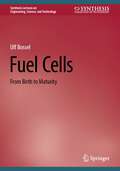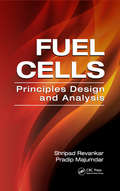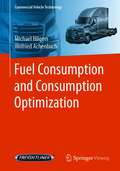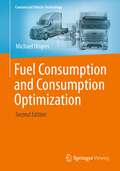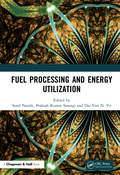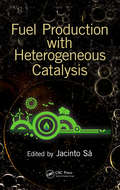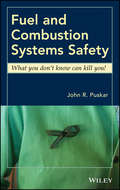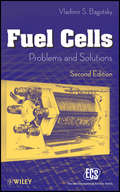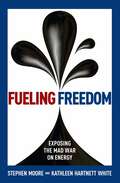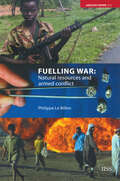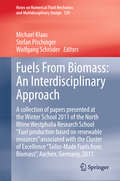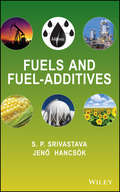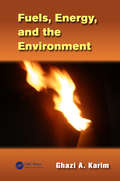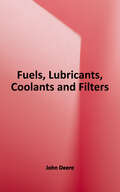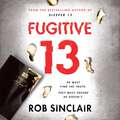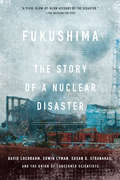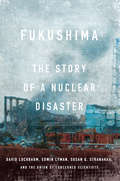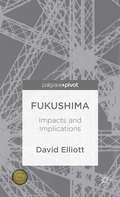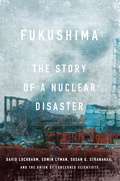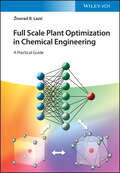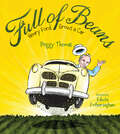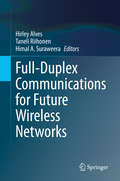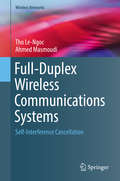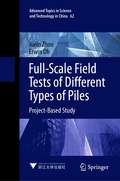- Table View
- List View
Fuel Cells: From Birth to Maturity (Synthesis Lectures on Engineering, Science, and Technology)
by Ulf BosselThe book presents the scientific history of the early days of fuel cells (1838 to 1845). The fuel cell effect was discovered by the Swiss scientist Christian Friedrich Schoenbein. while the English lawyer and scientist William Robert Grove perfected the idea into a working power source. But around 1870 Siemens invented the power generator and electricity was produced by rotating shafts of water wheels, engines and turbines. The book presents for the first time the complete communication between C. F. Schoenbein and R. W. Grove (1838 to 1868). Also, the original analysis based on the physical understanding of 1850 has also been revised and corrected. The updated fuel cell analysis leads to full agreement between theory and experiment.Updated and corrected fuel cell theoryHistoric review of discovery of fuel cell effect and early development of fuel cell generatorsComplete correspondence between Schoenbein and Grove from 1838 to 1868 (first publication)
Fuel Cells: Principles, Design, and Analysis (Mechanical and Aerospace Engineering Series)
by Shripad T. Revankar Pradip MajumdarFuel Cells: Principles, Design, and Analysis considers the latest advances in fuel cell system development and deployment, and was written with engineering and science students in mind. This book provides readers with the fundamentals of fuel cell operation and design, and incorporates techniques and methods designed to analyze different fuel cell
Fuel Consumption and Consumption Optimization (Commercial Vehicle Technology)
by Michael Hilgers Wilfried AchenbachThe aim of this work, consisting of 9 individual, self-contained booklets, is to describe commercial vehicle technology in a way that is clear, concise and illustrative. Compact and easy to understand, it provides an overview of the technology that goes into modern commercial vehicles.Starting from the customer's fundamental requirements, the characteristics and systems that define the design of the vehicles are presented knowledgeably in a series of articles, each of which can be read and studied on their own. In this volume, Fuel Consumption and Consumption Optimization, the main focus is placed on the factors for optimizing consumption in the conventional vehicle. Fuel consumption can be optimized by four different factors: the technology of the vehicle, the conditions of its operation, the behavior of the driver and the maintenance and upkeep of the vehicle. These aspects are described in a way that is easily understood for training and practical application.
Fuel Consumption and Consumption Optimization (Commercial Vehicle Technology)
by Michael HilgersThe aim of this work, consisting of 9 individual, self-contained booklets, is to describe commercial vehicle technology in a way that is clear, concise and illustrative. Compact and easy to understand, it provides an overview of the technology that goes into modern commercial vehicles.Starting from the customer's fundamental requirements, the characteristics and systems that define the design of the vehicles are presented knowledgeably in a series of articles, each of which can be read and studied on their own. In this volume, Fuel Consumption and Consumption Optimization, the main focus is placed on the factors for optimizing consumption in the conventional vehicle. Fuel consumption can be optimized by four different factors: the technology of the vehicle, the conditions of its operation, the behavior of the driver and the maintenance and upkeep of the vehicle. These aspects are described in a way that is easily understood for training and practical application.
Fuel Processing and Energy Utilization
by Prakash Kumar Sarangi Sonil Nanda Dai-Viet N. VoThis book provides different aspects on fuel processing and refinery for energy generation. Most updated research findings along with case studies, real scenario examples, and extensive analyses of original research work and literature reviews is included in this book.
Fuel Production with Heterogeneous Catalysis
by Jacinto SáThis book presents the current state of the art and future perspectives of the heterogeneous catalytic production of fuels, complete with reaction mechanism schemes, engineering solutions, and valuable industry insights. It describes production of fuels from renewable sources using environmentally friendly technologies, exposing the advantages and disadvantages of each production process and suggesting solutions to minimize the impact of fuel transportation. Comprised of chapters authored by leading experts in the field, this authoritative text conveys the importance of catalysis for the sustainable production of fuels.
Fuel and Combustion Systems Safety
by John R. PuskarPractical, easy-to-follow advice that saves livesBased on the author's thirty years of hands-on experience working in the field of industrial fuel systems and combustion equipment safety, this book integrates safety codes with practical, tested, and proven guidance that makes it viable to specify, operate, and maintain industrial fuel and combustion systems as safely as possible. Readers will learn about fuels, piping, combustion, controls, and risks from more than fifty "real-life stories" the author has integrated into each chapter so one can immediately see and understand the concepts presented.The incidents depicted resulted in forty-six deaths, hundreds of serious injuries, and billions of dollars in losses. Each example is followed by lessons learned, helping readers understand what could have been done to avoid the disaster or minimize the resulting destruction of life and property.The book begins with an introductory chapter that presents key concepts in industrial fuel and combustion systems safety. Next, chapters cover such topics as:Combustion and natural gas piping basicsGas supply system issuesGas piping repairs and cleaningFuel trains and combustion equipmentBoilers and their unique risksControlling combustion risks: people, policy, equipmentThe final two chapters address risks related to facilities outside of the United States, as well as business contingency planning related to fuels and combustion equipment. The last chapter explains how to plan for and then respond quickly and effectively to fuel or combustion system incidents.Filled with practical, easy-to-follow advice that saves lives, Fuel and Combustion Systems Safety is an essential reference for everyone from equipment operators and maintenance personnel to corporate risk managers and global safety directors.
Fuel cells
by Vladimir S. BagotskyThe comprehensive, accessible introduction to fuel cells, their applications, and the challenges they pose Fuel cells-electrochemical energy devices that produce electricity and heat-present a significant opportunity for cleaner, easier, and more practical energy. However, the excitement over fuel cells within the research community has led to such rapid innovation and development that it can be difficult for those not intimately familiar with the science involved to figure out exactly how this new technology can be used. Fuel Cells: Problems and Solutions, Second Edition addresses this issue head on, presenting the most important information about these remarkable power sources in an easy-to-understand way. Comprising four important sections, the book explores: The fundamentals of fuel cells, how they work, their history, and much more The major types of fuel cells, including proton exchange membrane fuel cells (PEMFC), direct liquid fuel cells (DLFC), and many others The scientific and engineering problems related to fuel cell technology The commercialization of fuel cells, including a look at their uses around the world Now in its second edition, this book features fully revised coverage of the modeling of fuel cells and small fuel cells for portable devices, and all-new chapters on the structural and wetting properties of fuel cell components, experimental methods for fuel cell stacks, and nonconventional design principles for fuel cells, bringing the content fully up to date. Designed for advanced undergraduate and graduate students in engineering and chemistry programs, as well as professionals working in related fields, Fuel Cells is a compact and accessible introduction to the exciting world of fuel cells and why they matter.
Fueling Freedom: Exposing the Mad War on Energy
by Stephen Moore Kathleen Hartnett WhiteFossil fuel energy is the lifeblood of the modern world. Before the Industrial Revolution, humanity depended on solar energy captured in living plants. But with the ability to harness the energy in coal and other fossil fuels, human quality of life and capacity for progress increased exponentially. With the recent advent of safe fracking techniques and incredible innovations in the energy industry, fossil fuels are as promising an energy resource as ever. Yet, highly politicized climate policies are pushing a grand-scale shift to new and less efficient energy sources. Is such a shift really necessary? If fossil fuel energy is supplanted by less efficient and less affordable alternatives for political reasons, will the modern world suffer?
Fuelling War: Natural Resources and Armed Conflicts (Adelphi series #373)
by Philippe Le BillonA generous endowment of natural resources should favour rapid economic and social development. The experience of countries like Angola and Iraq, however, suggests that resource wealth often proves a curse rather than a blessing. Billions of dollars from resource exploitation benefit repressive regimes and rebel groups, at a massive cost for local populations. This Adelphi Paper analyses the economic and political vulnerability of resource-dependent countries; assesses how resources influence the likelihood and course of conflicts; and discusses current initiatives to improve resource governance in the interest of peace. It concludes that long-term stability in resource-exporting regions will depend on their developmental outcomes, and calls for a broad reform agenda prioritising the basic needs and security of local populations.
Fuels From Biomass: An Interdisciplinary Approach
by Michael Klaas Stefan Pischinger Wolfgang SchröderThe book reports on the results of the BrenaRo Winterschool 2011, held on November 21-22 in Aachen, Germany. The different chapters cover a number of aspects of the topic of energy generation, with a particular focus on energy generation from biomass. They presents new findings concerning engine development, process engineering, and biological and chemical conversion of biomass to fuels, and highlight the importance of an interdisciplinary approach, combining chemistry, biology and engineering research, to the use of renewable energy sources. All in all, this book provides readers with a snapshot of the state-of-the-art in renewable energy conversion, and gives an overview of the ongoing work in this field in Germany.
Fuels and Fuel-Additives
by S. P. Srivastava Jenõ HancsókExamines all stages of fuel production, from feedstocks to finished productsExploring chemical structures and properties, this book sheds new light on the current science and technology of producing energy efficient and environmentally friendly fuels. Moreover, it explains the role of fuel-additives in the production cycle. This expertly written and organized guide to fuels and fuel-additives also presents requirements, rules and regulations, including US and EU standards governing automotive emissions, fuel quality and specifications, alternate fuels, biofuels, antioxidants, deposit control detergents/dispersants, stabilizers, corrosion inhibitors, and polymeric fuel-additives.Fuels and Fuel-Additives covers all stages and facets of the production of engine fuels as well as heating and fuel oils. The book begins with a quick portrait of the future of fuels and fuel production. Then, it sets forth the regulations controlling exhaust gas emissions and fuel quality from around the world. Next, the book covers:Processing of engine fuels derived from crude oil, including the production of blending componentsProduction of alternative fuelsFuel-additives for automotive enginesBlending of fuelsKey properties of motor fuels and their effects on engines and the environmentAviation fuelsThe final chapter of the book deals with fuel oils and marine fuels. Each chapter is extensively referenced, providing a gateway to the primary and secondary literature in the field. At the end of the book, a convenient glossary defines all the key terms used in the book.Examining the full production cycle from feedstocks to final products, Fuels and Fuel-Additives is recommended for students, engineers, and scientists working in fuels and energy production.
Fuels, Energy, and the Environment
by Ghazi A. KarimThe need for cleaner, sustainable energy continues to drive engineering research, development, and capital projects. Recent advances in combustion science and technology, including sophisticated diagnostic and control equipment, have enabled engineers to improve fuel processes and systems and reduce the damaging effects of fuels on the environment.
Fuels, Lubricants, Coolants, and Filters
by John DeereThis book is the definitive "how-to" book when it comes to this subject - from showing you the different types of each; to their characteristics, designations, and additives; to diagnosing system problems and identifying parts failure; to explaining how to repair the systems.
Fugitive 13: The explosive thriller that will have you gripped (Sleeper 13 #2)
by Rob SinclairThe explosive, gripping new thriller from bestselling author Rob Sinclair - for fans of Orphan X, I Am Pilgrim and Nomad.Aydin Torkal - aka Sleeper 13 - is on the run.Hunted not only by the world's intelligence agencies, but also by the elite brotherhood of insurgents he betrayed, he has lived the past year like a ghost.Until now.MI6 agent Rachel Cox knows Aydin better than anyone. The only person who believes he is an ally in the ongoing war on terror, not the enemy. So when a coded message arrives from him, warning her not to trust her own colleagues, Rachel must choose between her career and the truth.But as Aydin hunts down those who destroyed his childhood, the trail he follows will lead him closer to home than he ever expected.He won't stop until he has his revenge.He is FUGITIVE 13.READERS ARE BEING GRIPPED BY THE SLEEPER 13 THRILLER SERIES:'Perfect for spy thriller lovers and fans of I Am Pilgrim, Orphan X' - Goodreads review'I could not put down this book' - Netgalley reviewer'Brilliant, gripping' - Netgalley reviewer
Fugitive 13: The second action-packed, thrilling instalment of the best-selling, gripping series (Sleeper 13 #2)
by Rob SinclairThe explosive second book in the SLEEPER 13 thriller series, by Rob Sinclair - for fans of Orphan X, I Am Pilgrim and Nomad.Aydin Torkal - aka Sleeper 13 - is on the run.Hunted not only by the world's intelligence agencies, but also by the elite brotherhood of insurgents he betrayed, he has lived the past year like a ghost.Until now.MI6 agent Rachel Cox knows Aydin better than anyone. The only person who believes he is an ally in the ongoing war on terror, not the enemy. So when a coded message arrives from him, warning her not to trust her own colleagues, Rachel must choose between her career and the truth.But as Aydin hunts down those who destroyed his childhood, the trail he follows will lead him closer to home than he ever expected.He won't stop until he has his revenge.He is FUGITIVE 13.
Fukushima
by The Union of Concerned Scientists David Lochbaum Edwin Lyman Susan Q. Stranahan"A gripping, suspenseful page-turner" (Kirkus Reviews) with a "fast-paced, detailed narrative that moves like a thriller" (International Business Times), Fukushima teams two leading experts from the Union of Concerned Scientists, David Lochbaum and Edwin Lyman, with award-winning journalist Susan Q. Stranahan to give us the first definitive account of the 2011 disaster that led to the worst nuclear catastrophe since Chernobyl.Four years have passed since the day the world watched in horror as an earthquake large enough to shift the Earth's axis by several inches sent a massive tsunami toward the Japanese coast and Fukushima Daiichi nuclear power plant, causing the reactors' safety systems to fail and explosions to reduce concrete and steel buildings to rubble. Even as the consequences of the 2011 disaster continue to exact their terrible price on the people of Japan and on the world, Fukushima addresses the grim questions at the heart of the nuclear debate: could a similar catastrophe happen again, and--most important of all--how can such a crisis be averted?
Fukushima
by The Union of Concerned Scientists David Lochbaum Edwin Lyman Susan Q. StranahanOn March 11, 2011, an earthquake large enough to knock the earth from its axis sent a massive tsunami speeding toward the Japanese coast and the aging and vulnerable Fukushima Daiichi nuclear power reactors. Over the following weeks, the world watched in horror as a natural disaster became a man-made catastrophe: fail-safes failed, cooling systems shut down, nuclear rods melted. In the first definitive account of the Fukushima disaster, two leading experts from the Union of Concerned Scientists, David Lochbaum and Edwin Lyman, team up with journalist Susan Q. Stranahan, the lead reporter of the Philadelphia Inquirer's Pulitzer Prize-winning coverage of the Three Mile Island accident, to tell this harrowing story. Fukushima combines a fast-paced, riveting account of the tsunami and the nuclear emergency it created with an explanation of the science and technology behind the meltdown as it unfolded in real time. Bolstered by photographs, explanatory diagrams, and a comprehensive glossary, the narrative also extends to other severe nuclear accidents to address both the terrifying question of whether it could happen elsewhere and how such a crisis can be averted in the future.
Fukushima: Impacts and Implications
by David ElliottThe Fukushima nuclear disaster in March 2011 led Japan, and many other countries, to change their energy policies. David Elliott reviews the disaster and its global implications, asking whether, despite continued backing by some governments, the growing opposition to nuclear power means the end of the global nuclear renaissance.
Fukushima: The Story of a Nuclear Disaster
by David Lochbaum Edwin Lyman Union of Concerned Scientists Staff Susan Q. StranahanOn March 11, 2011, an earthquake large enough to knock the earth from its axis sent a massive tsunami speeding toward the Japanese coast and the aging and vulnerable Fukushima Daiichi nuclear power reactors. Over the following weeks, the world watched in horror as a natural disaster became a man-made catastrophe: fail-safes failed, cooling systems shut down, nuclear rods melted. In the first definitive account of the Fukushima disaster, two leading experts from the Union of Concerned Scientists, David Lochbaum and Edwin Lyman, team up with journalist Susan Q. Stranahan, the lead reporter of the Philadelphia Inquirer's Pulitzer Prize-winning coverage of the Three Mile Island accident, to tell this harrowing story. Fukushima combines a fast-paced, riveting account of the tsunami and the nuclear emergency it created with an explanation of the science and technology behind the meltdown as it unfolded in real time. Bolstered by photographs, explanatory diagrams, and a comprehensive glossary, the narrative also extends to other severe nuclear accidents to address both the terrifying question of whether it could happen elsewhere and how such a crisis can be averted in the future.
Full Scale Plant Optimization in Chemical Engineering: A Practical Guide
by Zivorad R. LazicHelp protect your network with this important reference work on cyber security Chemical engineers are a vital part of the creation of any process development—lab-scale and pilot-scale—for any plant. In fact, they are the lynchpin of later efforts to scale-up and full-scale plant process improvement. As these engineers approach a new project, there are three generally recognized methodologies that are applicable in industry generally: Design of Experiments (DOE), Evolutionary Operations (EVOP), and Data Mining Using Neural Networks (DM). In Full Scale Plant Optimization in Chemical Engineering, experienced chemical engineer Zivorad R. Lazic offers an in-depth analysis and comparison of these three methods in full-scale plant optimization applications. The book is designed to provide the basic principles and necessary information for complete understanding of these three methods (DOE, EVOP, and DM). The application of each model is further described. Full Scale Plant Optimization readers will also find: A thorough discussion of the advantages, disadvantages, and applications of the different simulation methods for process and plant optimization An overview of the tools that responsible operators and engineers utilize in deciding between different simulation models Particular attention is given to the simple but powerful technique Evolutionary Optimization or EVOP, which provides the experimental tools for the ideal full scale plant optimizationFull Scale Plant Optimization is a useful reference for all chemists in industry, chemical engineers, pharmaceutical chemists, and process engineers.
Full of Beans: Henry Ford Grows a Car
by Peggy ThomasA NSTA/CBC Best STEM BookFamous car-maker and businessman Henry Ford loved beans. And he showed great innovation with his determination to build his most inventive car--one completely made of soybeans.With a mind for ingenuity, Henry Ford looked to improve life for others. After the Great Depression struck, Ford especially wanted to support ailing farmers. For two years, Ford and his team researched ways to use farmers' crops in his Ford Motor Company. They discovered that the soybean was the perfect answer. Soon, Ford's cars contained many soybean plastic parts, and Ford incorporated soybeans into every part of his life. He ate soybeans, he wore clothes made of soybean fabric, and he wanted to drive soybeans, too. Award-winning author Peggy Thomas and illustrator Edwin Fotheringham explore this American icon's little-known quest.
Full-Duplex Communications for Future Wireless Networks
by Himal A. Suraweera Hirley Alves Taneli RiihonenThis book focuses on the multidisciplinary state-of-the-art of full-duplex wireless communications and applications. Moreover, this book contributes with an overview of the fundamentals of full-duplex communications, and introduces the most recent advances in self-interference cancellation from antenna design to digital domain. Moreover, the reader will discover analytical and empirical models to deal with residual self-interference and to assess its effects in various scenarios and applications. Therefore, this is a highly informative and carefully presented book by the leading scientists in the area, providing a comprehensive overview of full-duplex technology from the perspective of various researchers, and research groups worldwide. This book is designed for researchers and professionals working in wireless communications and engineers willing to understand the challenges and solutions full-duplex communication so to implement a full-duplex system.
Full-Duplex Wireless Communications Systems
by Tho Le-Ngoc Ahmed MasmoudiThis book introduces the development of self-interference (SI)-cancellation techniques for full-duplex wireless communication systems. The authors rely on estimation theory and signal processing to develop SI-cancellation algorithms by generating an estimate of the received SI and subtracting it from the received signal. The authors also cover two new SI-cancellation methods using the new concept of active signal injection (ASI) for full-duplex MIMO-OFDM systems. The ASI approach adds an appropriate cancelling signal to each transmitted signal such that the combined signals from transmit antennas attenuate the SI at the receive antennas. The authors illustrate that the SI-pre-cancelling signal does not affect the data-bearing signal. This book is for researchers and professionals working in wireless communications and engineers willing to understand the challenges of deploying full-duplex and practical solutions to implement a full-duplex system. Advanced-level students in electrical engineering and computer science studying wireless communications will also find this book useful as a secondary textbook.
Full-Scale Field Tests of Different Types of Piles: Project-Based Study (Advanced Topics in Science and Technology in China #62)
by Erwin Oh Jialin ZhouThis book provides full-scale field tests of different types of pile foundations. For the testing, it includes static load tests which consider various loading orientations, dynamic load tests, inclinometer monitoring and tests that aim to determine the load transfer mechanism of pile foundation. This book also covers the up-to-date popular topic with detailed project studies. This includes the academic investigation of post-grouting technology effect on drilled shaft piles, the research of displacement and non-displacement precast pile foundation, the study of fiber-reinforced polymer material used in the geo-technical environment such as deep excavation pit in tunneling project, and the research of super-long and large diameter pile foundations. These investigations provide essential and academic information for researchers as well as engineers in role of Civil and Geotech. Not only the different types of the piles are studied, but also the relevant theory and literatures are reviewed. In this book, the diagrams are plotted in an easy way and the explanation of the diagrams and tables are described in detail. The research methods corresponding to the practical projects are detailed as well. Hence, it is useful as a reference for the students and researchers in civil and geotechnical engineering.
